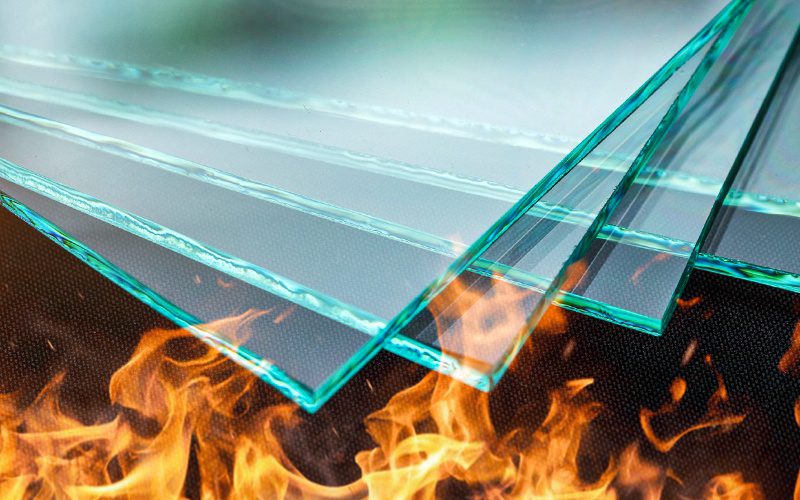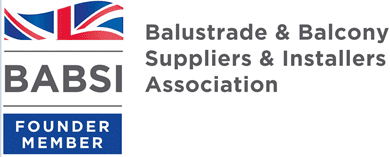Fire Rated Glass
Product Description
PLEASE NOTE: FIRE RESISTANT GLASS MUST BE USED AS PART OF AN APPROVED GLAZING SYSTEM TO ENSURE IT CONFIRMS WITH BUILDING REGULATIONS AND THE RELEVANT CERTIFICATION.
- Fire Resistance: Offers 30 minutes of fire integrity (E), preventing the spread of flames and smoke for that duration.
- Thickness: The 7.2mm thickness provides durability and fire resistance without compromising on clarity.
- Applications: Ideal for use in internal partitions, doors, and facades, ensuring both aesthetic appeal and critical fire protection.
- Certification: This product meets strict industry standards, complying with building regulations and fire safety requirements.
7.2mm Pyroguard Fire Rated Glass Specifications:
- Fire Rating: 30 minutes of integrity (E)
- Glass Thickness: 7.2mm
- Applications: Doors, partitions, and other fire-rated internal glazing installations
- Light Transmission: High levels of light transmission, ensuring visibility while maintaining safety
- Edge Profile: Suitable for a variety of frame systems
- Performance: High resistance to thermal stress and impact
7.2mm Clear 30 Minute Fire Rated Glass Max Sizes:
Installation into timber screen:
- 1070 x 2675mm
- 3125 x 1008mm
Installation into timber door:
- 760 x 1846mm
Installation into steel door:
- 835 x 2066mm
Installation into steel screen:
- 902 x 2570mm
- 1195 x 1170mm
£320.17
- This product is manufactured in the UK.
Description
Fire-rated glass plays a critical role in protecting lives and property by limiting the spread of fire and smoke in buildings. Our 7.2mm Pyroguard offers an effective solution for fire protection, providing integrity (E) ratings for up to 30 minutes, making it suitable for various applications where fire safety is essential.
What is Fire-Rated Glass?
Fire-rated glass is specially designed to withstand high temperatures and maintain its structure during a fire. It is rigorously tested to ensure that it can contain flames and smoke within a designated area, giving occupants more time to evacuate and allowing firefighters to manage the situation more effectively. This type of glass is an integral part of building safety regulations and is often installed in fire doors, partitions, and other internal structures to enhance safety.
Where to Use 7.2mm Pyroguard Fire Rated Glass
This fire-rated glass is ideal for commercial and residential buildings where safety regulations require the containment of fire. It can be installed in:
- Fire-rated doors: Ensuring protection without compromising design
- Internal partitions: Keeping fire contained in specific zones
- Public buildings and spaces: Where fire safety regulations are particularly stringent
Benefits of Choosing 7.2mm Pyroguard
- Safety Compliance: Fully compliant with UK building regulations for fire safety
- Aesthetic Appeal: Maintains the visual clarity of traditional glass, making it an ideal choice for both modern and classic designs
- Light Transmission: Allows natural light to flow while providing essential fire protection
- Versatility: Suitable for a wide range of internal applications, ensuring flexibility in design and use
How Fire Rated Glass Works
Fire-rated glass is engineered to remain intact during a fire, preventing flames and smoke from passing through. The 7.2mm Pyroguard offers a 30-minute integrity rating, meaning it can withstand the heat of a fire for half an hour, providing essential time for evacuation and firefighting efforts.
Frequently Asked Questions
Why is using fire-resistant glass so important?
Standard toughened glass is not heat-resistant enough to hold up against the high temperatures of fires, so it is critical to use specially manufactured fire-rated glass to create protective barriers that can help to stop flames from spreading.
Fire-resistant glass in doors and partitions can keep flames compartmentalised where they occur for a minimum of 30 minutes, keeping the surrounding passageways as clear as possible so anyone in the building can safely evacuate.
This also makes it easier for firefighters to tackle the fire when they arrive at the scene, reducing the risk of injuries and fatalities while also limiting the amount of fire, smoke, and water damage to the rest of the building.
It’s impossible to overstate the importance of measures like fire-rated glazing in fire safety systems and evacuation plans, which is why their manufacture and installation must legally comply with building regulations and safety standards.
What does an EW rating mean for fire glass?
As it is such a crucial element of fire safety, fire-resistant glass is subjected to standardised tests and given ratings to signify how long it can maintain its protective properties in the conditions of a fire, which must be at least 30 minutes.
The letter ‘E’ represents the integrity of the glass against flames and hot gases, while the letter ‘I’ represents insulation against heat transmission. When ‘W’ is used, this means the glass protects against radiation of heat to an extent, which is usually kept to within 15 kW/m2 on the opposite side of the glass from the fire.
For example, our EW30 fire-rated glass offers integrity against flames and reduction of heat radiation for 30 minutes. Depending on the type of glass and system, we can also supply fire glass that lasts up to 60–120 minutes.
For more technical details about our product options, get in touch with the Express Toughening team.
Where should fire-rated glass be installed?
Not all glass used in buildings needs to be fire-resistant, but there are some uses where fire-rated glass may be necessary. These include glass doors, windows, and screens that separate different areas of a building, such as entrances/exits, stairwells and hallways, and open areas like foyers, atria, or lobbies.
These are key places where the spread of a fire can be stopped, as fire-resistant glass can prevent the fire from moving from one part of the building to another for enough time that occupants can evacuate, and the emergency services can arrive.
It is the building owner’s responsibility to ensure that fire glass is installed wherever it is required by law, to the minimum specifications that these legal standards require. It’s therefore important to consult local and national regulations for building safety and fire safety when designing and installing elements involving glass and fire resistance.
How can you tell if glass is fire rated?
In the UK, it is a legal requirement that fire-rated glass products are etched with a permanent stamp with the name of the glass product, the manufacturer / supplier name, and preferably the performance rating the glass is certified to.
When and why are fire doors required?
If you’re designing a new build or renovating a property with more than three storeys (including loft conversions), fire-rated doors are required to separate the stairwell from each habitable room that connects to it. In two-storey homes, fire-rated doors are also essential if there is a door leading from a garage into the main house.
The primary purpose of fire-rated glazing in doors is to protect escape routes for a specified period, ensuring everyone can safely exit the building in the event of a fire. These systems also help slow the spread of fire throughout the property, giving the fire service additional time to contain the blaze before it escalates.
Fully glazed fire doors not only provide critical fire protection but also allow natural light to flow through the building. This creates a sense of openness and brightness, even in areas that need to be compartmentalised for safety.
What Should I Consider When Specifying Fire-Rated Glass?
When specifying fire-rated glass, it’s essential to consider both the glass and the framing system. Fire-rated glazing must strictly adhere to the certified test evidence and classifications – deviations from these can compromise safety. The fire rating classification for each system is crucial, as it reflects the system’s tested ability to withstand fire.
Fire-rated glazing is categorised by the duration it can protect against fire. Different glass types offer varying levels of fire resistance, so it’s important to know the required fire rating for your project. Building Regulations Part B provides detailed guidance on where fire-rated systems are required, with specifications varying depending on the building’s design, its use, and available escape routes for occupants.
How is fire rated glass classified?
Fire-rated glass is classified based on the amount of time it provides integrity and insulation during a fire. These categories are measured as follows:
Integrity Period
The integrity rating refers to how long the glass remains securely in its frame and prevents the passage of flames and hot gases when exposed to fire. This rating indicates how effectively the glass can withstand fire without breaking or allowing the fire to spread.
Insulation Period
The insulation rating measures how long the glass acts as a barrier against flames, heat, and smoke. During testing, the glass must prevent the temperature on the non-fire side from exceeding an average of 140°C, with no single point reaching more than 180°C.
Fire-rated glass classifications are based on the duration of protection for both integrity and insulation, with the following designations:
•E: Glass with an integrity-only rating
•EI: Glass with both integrity and insulation ratings
•EW: Glass with an integrity rating and limited heat resistance
These classifications help ensure the appropriate level of fire protection based on the needs of the building and its occupants.
Can Fire-Rated Glass Installations Be Frameless?
Yes, frameless fire-rated glass installations are possible; however, they require a recessed timber frame within the wall to ensure the system maintains its integrity during a fire. This recessed frame supports the glass while providing the appearance of a frameless design.
Frameless fire-rated glass is suitable for internal use only and is not recommended for environments like indoor swimming pools. The high temperature, humidity, and chemicals in pool environments can degrade the thermoplastic spacer (TPS) around the glass, compromising the performance of the frameless fire-rated system.
In frameless structural glazing with glass-to-glass joints, a TPS, typically made of silicone, is used along the edge of the glass. These joints are about 10-12mm wide with a 68mm black silicone seal, resulting in a visible joint of approximately 26-32mm running vertically along the glass.
Both frameless internal windows and doors can be manufactured with fire-rated properties, offering a modern, sleek look while maintaining fire protection. Frameless fire-rated windows allow unobstructed light flow within a building, and internal glazed fire doors—available as single or double pivot doors—combine fire safety with a minimalist aesthetic, making them an ideal solution for contemporary interiors where fire protection is required.
Can Any Lock Be Fitted onto a Fire-Rated Door?
No, only fire-rated locks and handles should be fitted onto a fire-rated door. In the event of a fire, metal components can heat up rapidly, weakening the overall door system. To ensure safety, it is crucial that the locking mechanism and handles are fully certified for fire resistance, maintaining their integrity under extreme temperatures. Using non-certified components can compromise the fire protection offered by the door.




